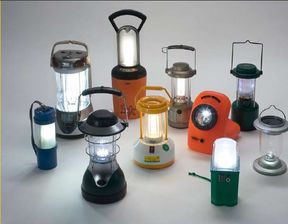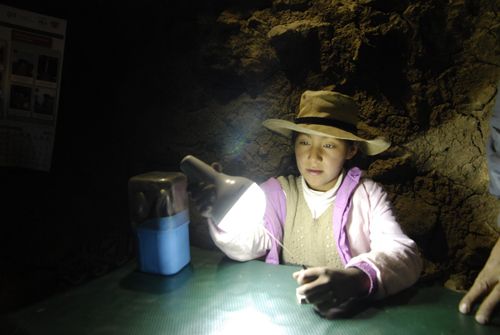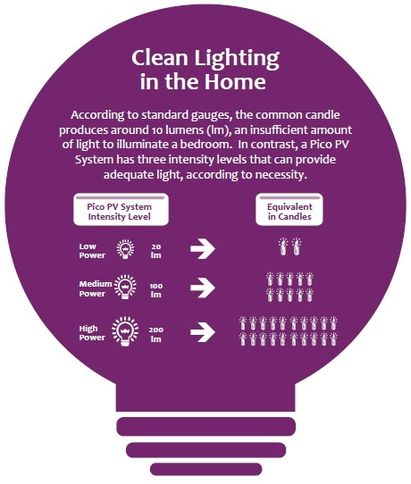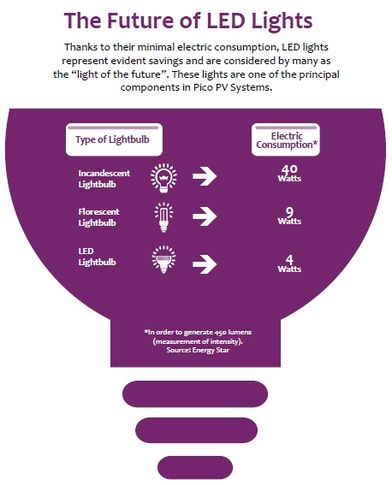Difference between revisions of "Features of PicoPV Systems"
***** (***** | *****) |
***** (***** | *****) |
||
| Line 58: | Line 58: | ||
<u>PicoPV Lamps</u><ref>GTZ. 2009. Solar Laterns Test: Shades of Light.</ref>: | <u>PicoPV Lamps</u><ref>GTZ. 2009. Solar Laterns Test: Shades of Light.</ref>: | ||
| − | [[File:PicoPV Solarleuchten.JPG|thumb|left|288px|PicoPV Lamps]]< | + | [[File:PicoPV Solarleuchten.JPG|thumb|left|288px|PicoPV Lamps]]<div style="clear:both"></div> |
| + | |||
| + | [[Features of PicoPV Systems#toc|►Go to Top]] | ||
| + | |||
= Project Examples<br/> = | = Project Examples<br/> = | ||
Revision as of 13:55, 29 September 2015
Overview
Photovoltaic (PV) off-grid systems are mainly defined through power dimension and the number of users[1].
All systems include one or more solar modules of different sizes and various appliances. Frequently used categories are multi-user systems (MUSs), solar home systems (SSHs) and the very small PicoPV systems.
Different PV system sizes[2]:
PicoPV systems are small independent appliances providing light and/or additional small electrical services, such as radios, mobile phone charging, mp3 player, etc. These systems allow the substitution of traditional light sources like inefficient and relatively dark kerosene lamps.
PicoPV System Components
A PicoPV system mainly consists of three components:
- Solar Panel: The PV panels for the lights are mostly made of polycrystalline or mono-crystalline silicon. The nameplate power ranges from 0.3 Wp for a solar lantern with an integrated panel up to 12 Wp for the combined system. The majority of the systems are equipped with panels from 1 to 3 Wp.
- Battery: There are different types of batteries used in the systems: lead-acid (33%) and NiMH (60%) batteries being the most common types, while Li-Ion (7%) batteries are presently used only in few cases. [3] The trend of using PicoPV systems with NiMH and Lithium ion is increasing and these batteries also replace the lower quality batteries, such as the lead-acid battery. Comparing NiMH and Lithium ion batteries, NiMH show memory effects and lower power than Lithium ion.[3] Along with the batteries, a charge controller is also important to protect the battery from damage caused by overcharging or deep-discharging. [4]
- Lamp: A PicoPV system can be equipped with various lighting technologies. Compact fluorescent lamps (CFL) are based on the same functional principle as standard fluorescent lamps, but are more energy efficient than the latter as they work at a higher internal pressure, are smaller and have a higher illuminating power. At present the light emitting diode (LED) technology seems to be the most forward-looking option. Although this light source still lacks behind the light output of energy-efficient CFL, LED lamps consume less energy, while their quality standards are improving at a fast pace. Both CFL and LED bulbs outperform by far the traditional lighting technologies based on kerosene, biomass, diesel, propane and wax (used by 14% of urban households and 49% of rural households in the developing world (IEA 2002 cited in Mills 2005), in terms of output of lumen per watt.
An increasing number of mature PicoPV systems provide additional energy services through various appliances which can be integrated in a multipurpose system or connected as external devices through a plug:
- ICT Appliances:The presently most common and popular appliance is a mobile phone charger which is either connected to the main device (the lamp) through a cable for charging from the battery, or directly to the module. These systems usually come with a set of different phone charging pins intended to cover a range of the most widely spread mobile phone types.
Many models of PicoPV systems also allow for the operation of other small electric devices such as a small radio, small loudspeakers, or a MP3-player. In general, the size of the module and the storage capacity of the battery determine the range of electric appliances which can be connected to the system. If required even a small TV or a little fridge can be operated. One example is the seven inch solar LCD Colour TV of Free Energy Europe which consumes less than 10 W per hour. In addition, various standard plugs USB-ports are also on the rise. They facilitate the operation of a huge range of small USB-devices like for example small fans.
Product Types
New products are introduced to the market nearly daily. Even though, there is no common typology of lamps yet, a few insititutions refer to a typology of products in order to differentiate between the big range of PicoPV products.
Quality of PicoPV Systems
In the recent years, a large number of differnt solar lamps has been introduced to the market. The number of new models increases almost daily. Therefore, it is difficult to find an adequate solar lamp regarding type and quality. In order to prevent customers from products of bad quality and destroy local markets, several laboratory tests were accomplished to evaluate products. To complement this data, field tests in various countries took place in order to test the products under real-life conditions.
Lighting africa developed a comprehensive quality test method (QTM) and established a minimum performace requirements for the Pico PV systems. Here you can find a list of the products that met the minimum quality standards.[2]
-> For more information on quality issues of Pico PV systems, please see Quality of Pico PV Systems.
PicoPV Lamps[5]:
Project Examples
PicoPV Systems in Peru
An Alternative for Home Lighting for Rural and Dispersed Populations
According to the National Rural Electrification Plan 2012-2021 from the Ministry of Energy and Mines, despite efforts to implement rural electrification projects, 3 million people in Peru still lack access to electricity and are forced to use batteries, candles and lighters, spending about 40 soles per month on low quality lighting.
Given this reality, PicoPV provide an alternative pre-electrification plan for remote and scattered rural communities throughout Peru. The PicoPV products are inexpensive, easy to transport (less than 2 kg), and involve simple installation, use and maintenance. They also have high energy efficiency, providing quality lighting that meets the daily needs of a family, while consuming less than 1 kWh per month. The systems can be used in a fixed or portable manner, and they can charge a radio or cell phone and in this way allow low income families to cut down on their daily spending. They provide greater security for the family and eliminate household pollution created by the use of diesel and other fuels used in rustic lighting. They are also a source of clean energy which decrease CO2 emissions in the environment.
Smoke-free Lighting and Savings
PicoPV products seek to improve the quality of life for families and communities that still lack permanent power sources. They do so by directly addressing the basic needs of the large segment of the population, in many countries, that live in remote, rural areas, far from the conventional electric network. And thanks to its small size, the systems can use high quality Lithium-ion batteries, the same as those used in cell phones and laptops, leaving behind lead-acid batteries, which pose an environmental and health risk.
Also, due to its small size, the system can, in good conditions and when fully charged, be used for up to 6 consecutive hours at the maximum intensity level (greater than 100 lumens) and up 50 hours at the minimum intensity level (greater than 20 lumens). Thus, given that these systems have different levels of intensity, the user can manage the stored energy as needed.
Financial gain is a powerful motive. A typical energy consumer spends about 30 or 40 soles in batteries, fuel or candles for lighting. Thus, a Pico PV system, the price of which varies between 50 and 100 dollars, depending on the model and brand, is equal to the cost of a half of a year of traditional lighting, with the advantage that it does not entail any future costs. Because of the savings and positive impacts provided in health, education and communication, Pico PV is a step towards a better quality of life.
Usually, the lights have an input jack where you insert the cable coming from the solar panel, which is installed on the roof of the house and which must stay connected during the day to recharge. Once charged, it is possible to use the accumulated electricity, not just for lighting, but also to recharge cell phones and radios, via an output cable, which is connected to the battery.
This is why Pico PV Systems are more than simple solar lights; they are integral domestic systems for lighting and basic communication. The purpose of Pico PV is not just to provide lighting at night, but also to open a window to communications technology, which is vital to the 21st century citizen.
It was necessary to create a lightweight and durable product that could be taken to remote areas without difficulties. In general, these systems are modular and are purchased as part of a kit, which includes a light with battery, a 3 Wp solar panel, phone charger, cables and accessories. A second light can also be acquired separately and charged by the same panel. In addition, a basic kit does not weigh more than 2 kg and can therefore be easily transported to remote areas.
Normally, solar panels are installed and remain stationary on the roof of the home, pointing north, so that it receives sun all day. One panel can charge up to two lights, which provides lighting for two rooms. In addition, most systems can be transported easily from room to room or carried as flashlights, because each light has its own battery, and certain models are even designed to be resistant to water, dust and impact.
Finally, for a product to be considered a Pico Photovoltaic System, it must have a maximum of 10 Wp panel, from which the light fixtures should be able to put out at least 100 lumens.
Opening the Doors to the Local Market
In Peru, the first products of this kind appeared in the capital in 2010. However, the market is still growing and therefore, they have mostly been utilized as part of projects that seek to promote human development through basic access to energy in the home, which is why the supply of these products has gone hand in hand with social initiatives from international cooperation organizations and the private sector.
These systems offer features suitable for remote locations, where installing other, more complex and powerful technologies, would be too costly or complicated for the locals. Also, this is an electrification alternative that comes with a guarantee from suppliers. Currently, they are working on providing a deal which includes a permanent service technicians in the San Martin region and replicating this model in Cusco and Cajamarca, according to the growth of the demand of the population. Generally the guarantee lasts one year. Moreover, these service centers are essential to the sustainability of the products, which may require maintenance, repairs or replacement batteries.
The GIZ’s Energising Development Project has been promoting the supply, demand and policy framework for these technologies in various regions of Peru, introducing products that have been tested for certain quality standards. Studies have been conducted in the laboratories of the National Engineering University (UNI) to ensure the capacity, efficiency and functionality of the systems.
The systems, tested in the field, have shown to be resistant to wear over time, and have generated positive social impact by replacing candles and diesel burners. There have been clear economic advantages, as the use of fuel for generators, which would light up one or two bulbs, has decreased sharply. This adds up to environmental conservation by contributing to the reduction of CO2 emissions.
The total replacement of batteries is still a work in progress, since some residents prefer having the equipment hanging in their rooms and not exposed to the elements, or they think equipment may be damaged by falling or getting wet and in some cases the residents have permanently installed the technology in their rooms and therefore continue to use regular flashlights for specific activities.
In addition, the use of batteries for radios is still common. However, there are now radios that work with USB music players and use cell phone batteries, which can be recharged via a Pico PV system.[6]
PicoPV Systems in Ethiopia
- To learn more about acceptance of PicoPV systems in Ethiopia, see Rural electrification and acceptance of PicoPV Systems
- For information about PicoPV market in Ethiopia, see Pico Solar PV System Market Assessment in Ethiopia
Further Information
- Solar portal on energypedia
- Market for PicoPV
- PicoPV Field Tests
- Quality of PicoPV Systems
- Financing Picopv
- PicoPV Database
- PicoPV Types
References
The article on PicoPV systems in Peru was originally published by EnDev Peru in the second issue of Amaray Magazine published in November 2012.
- ↑ Mitja et al., 2003
- ↑ 2.0 2.1 What difference can a PicoPV system make? Early findings on small Photovoltaic systems - an emerging low- cost energy technology for developing countries. Cite error: Invalid
<ref>tag; name "Difference" defined multiple times with different content - ↑ 3.0 3.1 Lighting Africa. 2010. Solar Lighting for the Base of the Pyramid - Overview of an Emerging Market - Cite error: Invalid
<ref>tag; name "BOP" defined multiple times with different content - ↑ Solar Energy Foundation. 2010. Sun connect. Check list solar lamps
- ↑ GTZ. 2009. Solar Laterns Test: Shades of Light.
- ↑ Peru: Amaray Magazine.
























